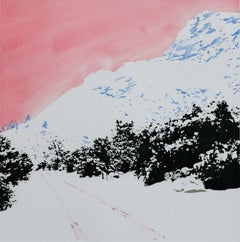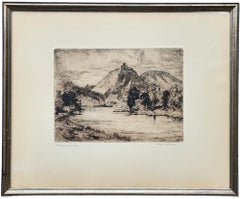Albert Meyeringh Art
to
1
1
1
1
Overall Height
to
Overall Width
to
1
1
1
1
6,847
3,161
2,517
1,217
1
Artist: Albert Meyeringh
Landscape
By Albert Meyeringh
Located in Chicago, IL
signed in plate
Category
18th Century Albert Meyeringh Art
Materials
Etching
Related Items
Pink Mountain
By Isca Greenfield-Sanders
Located in Berkeley, CA
Color spitbite aquatint and aquatint with drypoint.
Edition of 35
Category
2010s Contemporary Albert Meyeringh Art
Materials
Etching, Intaglio
Siebengebirge, circa 1920s Etching, Germany, Tugboat
Located in Grand Rapids, MI
Hans Füsser (German, 1898-1959)
Signed: Hans Füsser (Lower, Right)
" Siebengebirge ", circa 1920s
Etching
Plate Size: 6 1/4" x 8 1/2"
Housed in a 1/2" Frame
Overall Size: 12 3/...
Category
Early 20th Century Albert Meyeringh Art
Materials
Etching
The Thames, 1894 - Victorian aquatint etching of London by Joseph Pennell
By Joseph Pennell
Located in London, GB
JOSEPH PENNELL
(1857-1926)
The Thames, 1894
Signed
Aquatint
Plate size 20.5 by 26.5 cm., 8 by 10 ½ in.
(frame size 42 by 46 cm., 16 ½ by 18 in.)
Pennell was born in Philadelphia where he studied at School of Industrial Art and the Academy of Fine Arts. In 1884 he was commissioned by the Century Magazine to supply a series of drawings of London...
Category
1890s Realist Albert Meyeringh Art
Materials
Aquatint
The Wedding Procession - Le Cortege nuptial - 17thC Etching from Les Pastorales
By Claudine Bouzonnet-Stella
Located in Meinisberg, CH
Engraved by
Claudine Bouzonnet-Stella
(French, 1636-1697)
After
Jacques Stella (French 1596-1657)
The Wedding Procession - Le Cortege nuptial
• Copper engraving on laid paper
• Sh...
Category
17th Century Naturalistic Albert Meyeringh Art
Materials
Ink, Laid Paper, Etching
Free Shipping
H 9.73 in W 12.21 in D 0.4 in
My Village
By Ivan Rabuzin
Located in Ljubljana, SI
My Village. Original aquatint, 1981.
Ivan Rabuzin was a Croatian naive painter and one of the most eminent lyric painters of the 20th century in Croatia. For many years he worked as ...
Category
1980s Albert Meyeringh Art
Materials
Aquatint
Land
Located in Llanbrynmair, GB
'Land'
By Garrick Palmer with Eric Williams
Medium - Limited edition book of 240 copies, signed an dnumbered by the artist and presented in a clothbound slipcase.
Signed - Yes
Ed...
Category
Early 2000s Other Art Style Albert Meyeringh Art
Materials
Etching
Convertible
By Isca Greenfield-Sanders
Located in Berkeley, CA
Color spitbite aquatint and aquatint with drypoint.
Edition of 35
Category
2010s Contemporary Albert Meyeringh Art
Materials
Etching, Intaglio
Charing Cross Bridge - 1909 etching of London by Joseph Pennell
By Joseph Pennell
Located in London, GB
JOSEPH PENNELL
(1857-1926)
Charing Cross Bridge at Night, 1909
Signed
Etching
Plate size17.5 by 25 cm., 7 by 10 in.
(frame size 38.5 by 45 cm., 15 ¼ by 17 ¾ in.)
Pennell was born in Philadelphia where he studied at School of Industrial Art and the Academy of Fine Arts. In 1884 he was commissioned by the Century Magazine to supply a series of drawings of London...
Category
Early 20th Century Impressionist Albert Meyeringh Art
Materials
Etching
Two Houses
By K.B. (Kyu-Baik ) Hwang
Located in Ljubljana, SI
Original color aquatint and etching, 1978. Edition of 100 signed and numbered impressions on Arches paper.
Kyu-Baik Hwang is contemporary painter and printmaker, from South Korea. He...
Category
1970s Post-Modern Albert Meyeringh Art
Materials
Color, Etching, Aquatint
Evening - The depth of the visible -
Located in Berlin, DE
Max Clarenbach (1880 Neuss - Cologne 1952), Evening. Etching, 18 x 41 cm (platemark), 33.5 x 57 cm (frame), inscribed "Abend" in pencil at lower left, signed and dated "M. Clarenbach. 28.III.[19]09". Framed and mounted under glass.
- Somewhat browned and slightly foxed.
About the artwork
The horizontally elongated etching depicts the panoramic view of a small town as seen from the other side of the river. There are gabled houses on the left and a mighty church spire on the right. The bourgeois houses and the large religious building indicate the urban character. These buildings are rendered in dark tones to emphasise the lighter row of houses in the centre of the picture, closer to the water. The chiaroscuro contrast creates two parallel planes that open up a space for the imagination of what the city could be. The imagination is stimulated by the almost entirely dark, barely recognisable buildings, while the arm of the river leading into the city further stimulates the imagination.
However, as the silhouette of the city as a whole is reflected in the water, the parallel planes are perceived as a band of houses that stretches across the entire horizontality of the etching and seems to continue beyond the borders of the picture. The reflection has almost the same intensity as the houses themselves, so that the band of buildings merges with their reflection to form the dominant formal unit of the picture. Only the parallel horizontal hatching creates the convincing impression of seeing water, demonstrating Max Clarenbach's mastery of the etching needle.
The water is completely motionless, the reflection unclouded by the slightest movement of the waves, creating a symmetry within the formal unity of the cityscape and its reflection that goes beyond the motif of a mere cityscape. A pictorial order is established that integrates everything in the picture and has a metaphysical character as a structure of order that transcends the individual things. This pictorial order is not only relevant in the pictorial world, but the picture itself reveals the order of the reality it depicts. Revealing the metaphysical order of reality in the structures of its visibility is what drives Clarenbach as an artist and motivates him to return to the same circle of motifs.
The symmetry described is at the same time inherent an asymmetry that is a reflection on art: While the real cityscape is cut off at the top of the picture, two chimneys and above all the church tower are not visible, the reflection illustrates reality in its entirety. The reflection occupies a much larger space in the picture than reality itself. Since antiquity, art has been understood primarily as a reflection of reality, but here Clarenbach makes it clear that art is not a mere appearance, which can at best be a reflection of reality, but that art has the potential to reveal reality itself.
The revealed structure of order is by no means purely formalistic; it appears at the same time as the mood of the landscape. The picture is filled with an almost sacred silence. Nothing in the picture evokes a sound, and there is complete stillness. There are no people in Clarenbach's landscape paintings to bring action into the picture. Not even we ourselves are assigned a viewing position in the picture, so that we do not become thematic subjects of action. Clarenbach also refrains from depicting technical achievements. The absence of man and technology creates an atmosphere of timelessness. Even if the specific date proves that Clarenbach is depicting something that happened before his eyes, without the date we would not be able to say which decade, or even which century, we are in. The motionless stillness, then, does not result in time being frozen in the picture, but rather in a timeless eternity that is nevertheless, as the title "Abend" (evening), added by Clarenbach himself, makes clear, a phenomenon of transition. The landscape of the stalls is about to be completely plunged into darkness, the buildings behind it only faintly discernible. The slightly darkened state of the sheet is in keeping with this transitional quality, which also lends the scene a sepia quality that underlines its timelessness. And yet the depiction is tied to a very specific time. Clarenbach dates the picture to the evening of 28 March 1909, which does not refer to the making of the etching, but to the capture of the landscape's essence in the landscape itself.
If the real landscape is thus in a state of transition, and therefore something ephemeral, art reveals its true nature in that reality, subject to the flow of phenomena, is transferred to an eternal moment, subject to a supra-temporal structure of order - revealed by art. Despite this supratemporality, the picture also shows the harbingers of night as the coming darkening of the world, which gives the picture a deeply melancholy quality, enhanced by the browning of the leaf.
It is the philosophical content and the lyrical-melancholic effect of the graphic that give it its enchanting power. Once we are immersed in the image, it literally takes a jerk to disengage from it.
This etching, so characteristic of Max Clarenbach's art, is - not least because of its dimensions - a major work in his graphic oeuvre.
About the artist
Born into poverty and orphaned at an early age, the artistically gifted young Max Clarenbach was discovered by Andreas Achenbach and admitted to the Düsseldorf Art Academy at the age of 13.
"Completely penniless, I worked for an uncle in a cardboard factory in the evenings to pay for my studies.”
- Max Clarenbach
At the academy he studied under Arthur Kampf, among others, and in 1897 was accepted into Eugen Dücker...
Category
Early 1900s Realist Albert Meyeringh Art
Materials
Etching
Danae and Zeus by Deborah Brown
By Deborah Brown
Located in New York, NY
Deborah Brown
Danae and Zeus, 2021
Two plate sugar lift and aquatint etching printed on Rives BFK white paper
Image Size: 16 x 20 inches
Paper Size: 22 x 30 inches
Edition of 18 ...
Category
2010s Contemporary Albert Meyeringh Art
Materials
Etching
United Nations
By Bernard Buffet
Located in New York, NY
This is number #16 in the catalogue on the etchings of Bernard Buffet in a limited. The above size is the paper size and it is also framed. There is no fading or foxing in and on th...
Category
1950s French School Albert Meyeringh Art
Materials
Faience, Etching
Albert Meyeringh art for sale on 1stDibs.
Find a wide variety of authentic Albert Meyeringh art available for sale on 1stDibs. You can also browse by medium to find art by Albert Meyeringh in engraving, etching and more. Much of the original work by this artist or collective was created during the 18th century and earlier and is mostly associated with the Old Masters style. Not every interior allows for large Albert Meyeringh art, so small editions measuring 13 inches across are available. Customers who are interested in this artist might also find the work of Jacobus Houbraken, Johann Baptist Homann, and Frans Hogenberg. Albert Meyeringh art prices can differ depending upon medium, time period and other attributes. On 1stDibs, the price for these items starts at $450 and tops out at $2,000, while the average work can sell for $1,225.


